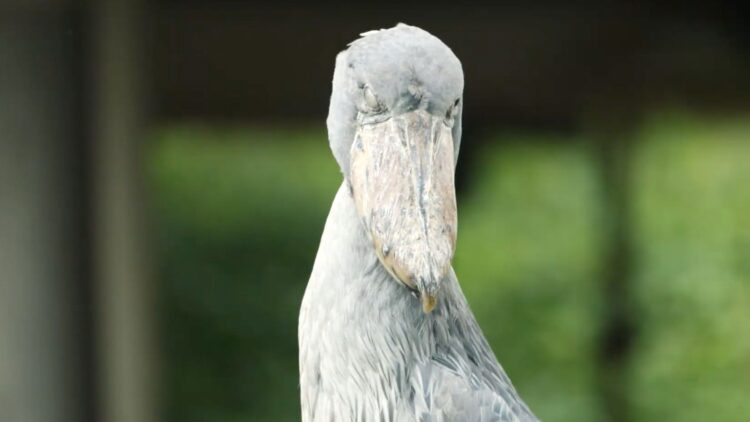There are animals that can only be seen in certain places on the planet, such as the shoebill, also known as the “dinosaur bird.” This bird, which can be found in Uganda, can measure up to 1.4 meters tall and have a wingspan of two meters. This animal has recently been seen on social media thanks to a video. The accompanying footage shows a shoebill that has just landed on a tourist boat in Mabamba Bay, Uganda, offering a captivating perspective that gives the bird a truly gigantic appearance.
They are classified globally as “vulnerable,” and there are fewer than 8,000 individuals
According to the most accurate data available about this animal, and as reported by the San Diego Zoo, this prehistoric-looking bird measures between 1.1 and 1.5 meters in length. That is, the largest specimens are about the size of an eight- to ten-year-old child. This animal gets its name from the shape of its enormous beaks, which resemble those of dinosaurs and are quite imposing up close. Specifically, they are classified globally as “vulnerable,” and there are fewer than 8,000 individuals throughout their range in central and eastern tropical Africa.
This type of bird lives in wetlands and marshes of East and Central Africa, according to the Dallas World Aquarium. You might find it in countries like Uganda, Tanzania, and Zambia. When its wings are spread, the shoebill measures 2.4 meters from tip to tip. “Today we experienced another unforgettable moment when the shoebill flew towards our boat,” Mabamba Trips posted on Instagram after capturing the bird in flight. The beak of these birds has sharp edges, which they can use to decapitate their prey (you read that right) or to separate vegetation that might be clinging to the fish while fishing. And while shoebills resemble storks, they are more closely related to pelicans and herons.
Mabamba Bay, on Lake Victoria, is a globally recognized Important Bird Area, where shoebills are protected
The upper mandible has a kind of claw, which helps to stop animals that are prone to slipping. In fact, the bird “claps” its beak to scare away intruders and attract a mate; the tone of the clap is different for males and females. Mabamba Bay, on Lake Victoria, is a globally recognized Important Bird Area, where shoebills are protected, along with blue swallows and papyrus gonoleks. Indeed, due to its size, the shoebill is a major attraction for birdwatchers who visit the wetland.
Their endangered status is due to habitat degradation, hunting, and the illegal pet trade
Some shoebills have striking pale blue eyes; in fact, their yellowish or grayish eyes, combined with their posture, can be even more intimidating. Shoebills can remain motionless for hours on end, according to the website Mental Floss. Furthermore, their fishing technique is known to be quite aggressive. When they spot potential prey, they rapidly plunge their beak into the water, quickly catching the animal. Once they have their prey, they move their mandibles from side to side to clear away any vegetation they may have accidentally caught, and then swallow the animal. This species is listed as vulnerable by the International Union for Conservation of Nature. As mentioned above, it is estimated that there are between 3,300 and 5,300 individuals in the wild. Their endangered status is due to habitat degradation, hunting, and the illegal pet trade.
Finally, it’s also interesting to note that shoebills rarely raise more than one chick. The younger chick serves as a backup in case the older one doesn’t survive. They feed on fish such as catfish and tilapia, as well as snakes, frogs, turtles, and baby crocodiles. Therefore, with a limited food supply, shoebill parents usually favor the older chick, thus ensuring the survival of at least one of their offspring. In short, it’s a rare bird to see, but for those who have been able to observe it in person, it’s magnificent. Its wings and resemblance to a prehistoric animal make it very striking and special, which is why it’s protected.

